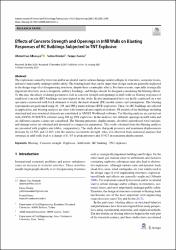| dc.contributor.author | Altunişik, Ahmet Can | |
| dc.contributor.author | Önalan, Fatma | |
| dc.contributor.author | Sunca, Fezayil | |
| dc.date.accessioned | 2022-05-11T14:49:49Z | |
| dc.date.available | 2022-05-11T14:49:49Z | |
| dc.date.issued | 2021 | tr |
| dc.identifier.citation | Received: 26 May 2020 / Accepted: 7 December 2020 / Published online: 18 January 2021
© Shiraz University 2021 | tr |
| dc.identifier.uri | https://hdl.handle.net/20.500.12418/12840 | |
| dc.description.abstract | The explosions caused by terrorism and/or accidental lead to serious damage and/or collapse in structures, economic losses, and most importantly endanger public safety. The blasting loads that can be larger than design loads are generally neglected in the design stage of civil engineering structures, despite these catastrophic effects. For these reasons, especially strategically important structures such as hospitals, military buildings, and bridges should be designed considering the blasting effects. To this aim, the effects of design parameters such as concrete strength and openings in infill walls on blasting responses of reinforced concrete (RC) buildings are investigated in this study. In situ experimental tests are firstly conducted on a test specimen constructed with brick elements to verify the finite element (FE) model criteria and assumptions. The blasting
experiments are performed using 40, 150, and 290 g trinitrotoluene (TNT) explosives. Then, two RC buildings are selected as application, and blasting analyses are done with numerical and empirical methods. FE models of the buildings including structural and non-structural elements are constituted in ANSYS Workbench software. The blasting analyses are carried out with ANSYS AUTODYN software using 100 kg TNT explosives. In the analyses, two different openings in infill walls and six different concrete classes are considered. The blasting pressures, displacements, absorbed and released total energies, and damage ratios are obtained and presented as comparison parameters. The results obtained from the blasting analyses are presented with graphics and tables, comparatively. The study shows that peak pressures and maximum displacements
decrease by 22.50% and 32.16% with the increase in concrete strength. Also, it is observed from numerical analyses that openings in infill walls lead to a change of 8.16% in peak pressures and 13.92% in maximum displacements. | tr |
| dc.language.iso | eng | tr |
| dc.relation.isversionof | 10.1007/s40996-020-00563-x | tr |
| dc.rights | info:eu-repo/semantics/closedAccess | tr |
| dc.subject | Blasting | tr |
| dc.subject | Concrete strength | tr |
| dc.subject | Explosion | tr |
| dc.subject | Infill walls | tr |
| dc.subject | RC building | tr |
| dc.subject | TNT explosive | tr |
| dc.title | Effects of Concrete Strength and Openings in Infill Walls on Blasting Responses of RC Buildings Subjected to TNT Explosive | tr |
| dc.type | article | tr |
| dc.relation.journal | Iranian Journal of Science and Technology, Transactions of Civil Engineering | tr |
| dc.contributor.department | Mühendislik Fakültesi | tr |
| dc.contributor.authorID | 0000-0003-3033-6237 | tr |
| dc.identifier.volume | 45 | tr |
| dc.identifier.endpage | 2554 | tr |
| dc.identifier.startpage | 2525 | tr |
| dc.relation.publicationcategory | Uluslararası Hakemli Dergide Makale - Kurum Öğretim Elemanı | tr |















